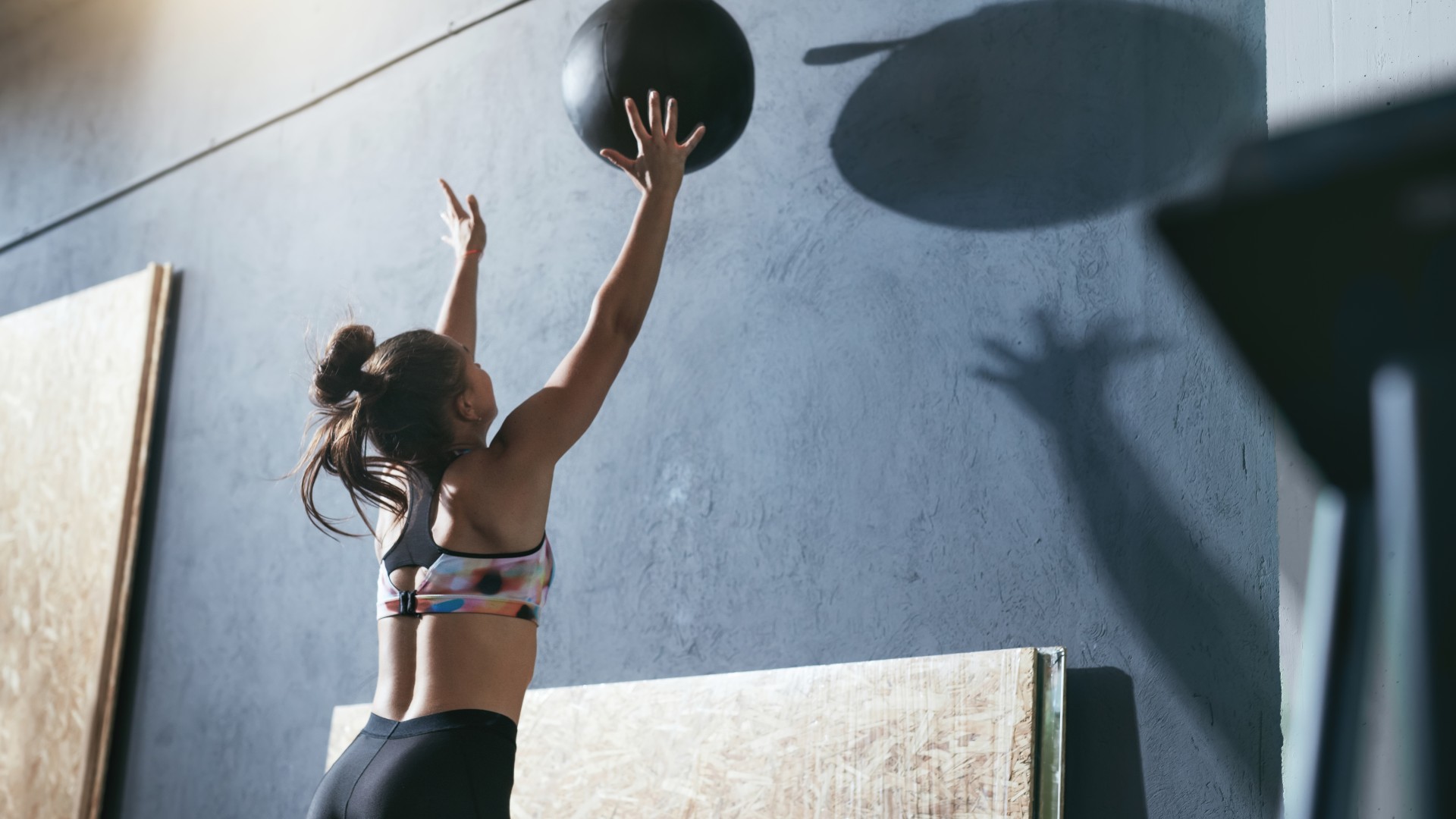
If one exercise will challenge your entire body, it’s wall balls. And you don’t need a gym — just any wall, anywhere, and a weighted ball. But perhaps take it outdoors if you have neighbors.
Wall balls are a staple functional exercise found in Hyrox workouts and CrossFit classes. The exercise involves squatting down while holding a ball, throwing it at the wall, and catching it as you squat down. You can use a lighter weight and increase the tempo to focus on cardio and endurance or lift heavier for strength training and building power. Either way, expect to increase your heart rate and strengthen the muscles in your legs, core, shoulders, and back.
Wall balls have been my arch-nemesis since staring down the barrel of 100 torturous reps at the Hyrox European Championships last month. I’ve vowed to work on them, so I picked up a ball and hit the walls for 50 reps a day to test my strength and endurance. Find out what happened to my body and how to do them below.
How to do wall balls
Grab a weighted ball and a sturdy wall or similar target you can confidently reach. I recommend beginners opt for a lighter ball until the catch and throw are consistent and you can find good depth in your squat. Check out the video to learn how to do wall balls with proper form and tips and tricks to hit more reps.
Aim for the same spot on the wall each time, and keep the ball close to your chest. Reps should be consistent, and each movement smooth to build up momentum.
Wall balls: muscles worked
You can build momentum on wall balls, delivering a full-body burn and building muscle all over. Expect to develop endurance and power, and strengthen major muscle groups, including your shoulders, chest, quads, glutes, hamstrings, and arm muscles.
Your core muscles help drive movement, keeping your spine stable as you throw, catch, and squat. The rotator cuff muscles stabilize your shoulders, and the lats engage as you throw. You can expect to kick up a burn in your arms, namely the triceps and biceps, during the throw motion.
Get instant access to breaking news, the hottest reviews, great deals and helpful tips.
I did 50 wall balls every day for a week — here's what happened
Here’s what 50 wall balls did to my body after one week.
It was a full-body workout
According to the CrossFit Journal, the wall ball drill brings together “two highly functional classical weightlifting movements” — the overhead press and squat — using lighter loads for an extended duration. The journal cites it as a “super-potent metabolic conditioning tool with enormous potential for increasing athletic performance.” Rowing regularly is another one, but it requires more kit.
I decided to hammer out 50 reps at 6kg with minimal rest. I gave my glutes a healthy squeeze at the top of the squats and drove up through my heels, core, and shoulders to generate explosive power for the throw. I felt this exercise everywhere, and as the next day DOMS firmly set in, I regretted my decision to commit to one giant set. My shoulders, glutes, and quads were in bits.
I’m used to seeing wall balls crop up during workouts, but usually with rest or lower reps. I was seriously puffing at 25 reps. Safe to say, it took me longer to get dressed the following day. By the end of the week, 30 reps felt more manageable, but I mentally blocked out the last 20.
My throwing improved
I don’t have a problem finding depth in my squats, but I struggle to find height and power in the throw, partly due to my dodgy left shoulder. My aim has always been sloppy, and I’ve wasted time resetting on the catch rather than landing confidently into the next rep. I was looking forward to practicing.
Throwing a ball at a wall might seem simple, but it’s surprisingly difficult to keep a vertical trajectory and not throw forwards, which comes down to positioning correctly — about an arm's length from the wall. I could feel the exercise dominating my quads during the loaded transition back into the squat, and a powerhouse of pain when throwing upwards against gravity and trying to stay balanced (which comes down to proper core contraction).
It took me a few days to consistently hit my target (and a lot of chaos), but I started to improve as the week went on. A crucial tip for throwing is keeping your elbows down and slightly cupping the ball while your hands are positioned on either side. Lift the chest and keep the bum down to help throw it upwards. As the movement pattern began to feel more comfortable, my aim and power became more consistent, and I was no longer chasing the ball — I’ll leave that to my dog.
I got quicker
According to the same journal, the wall ball exercise is an example of “high functionality and the marked carryover of cardiorespiratory benefits.” But I was interested to know what else throwing could do for my body. Aside from developing the muscles in my arms and legs, according to studies, throwing improves hand-eye bilateral coordination, increases stability and control, and improves communication between body parts. Interestingly, research has also shown that it could improve balance and reduce falls in older adults.
I’m under no illusion that my technique had transformed in just one week, but I did complete reps faster by controlling the movement with more fluidity, and I could see how time and practice could help anyone grab the benefits of wall balls. While it was no less punishing on my limbs, I felt far more confident in my ability.
Developing overhead pushing power also recruits similar muscles to the throw, so if you plan to work on your upper-body power and strength, adding exercises like Arnold presses and the Pallof press could develop shoulder and core strength and power.
Next up: I just competed at the Hyrox European Championships. Try this Hyrox workout, and our editor did 100 plank jacks every day for a week.

Sam Hopes is a level 3 qualified trainer, a level 2 Reiki practitioner and fitness editor at Tom's Guide. She is also currently undertaking her Yoga For Athletes training course.
Sam has written for various fitness brands and websites over the years and has experience across brands at Future, such as Live Science, Fit&Well, Coach, and T3.
Having coached at fitness studios like F45 and Virgin Active and personal trained, Sam now primarily teaches outdoor bootcamps, bodyweight, calisthenics and kettlebells.
She also coaches mobility and flexibility classes several times a week and believes that true strength comes from a holistic approach to training your body.
Sam has completed two mixed doubles Hyrox competitions in London and the Netherlands and finished her first doubles attempt in 1:11.

